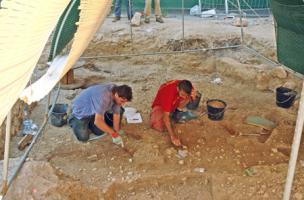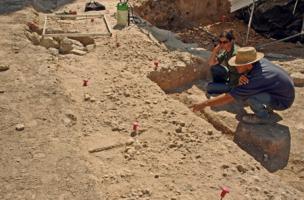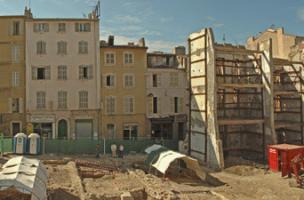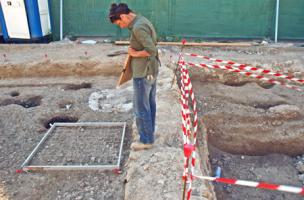Search
You are here
The first Marseillais dined on limpets and winkles !
A team from the Institut National de Recherches Archéologiques Préventives (Inrap),working in collaboration with the municipal archaeology service has just found the earliest signs of human occupation in the town centre of Marseille.
Chronicle of site
Post date
13 September 2005
Last modified
13 February 2017
This Neolithic site, of exceptional research interest, dates from the VIth and Vth millennium B.C. Archaeologists have been working since June on a plot of land on the rue Bernard Dubois, just opposite the Saint-Charles railway station, on which will be built a university hall of residence. The excavation is curated by the Regional Archaeology Service (DRAC Provence-Alpes-Côte-d'Azur.)
Context of the excavation
The Neolithic site of the ZAC Saint-Charles was discovered during an archaeological evaluation, carried out before work planned by Euroméditerranée. Located on an ancient interfluve between the Saint-Charles railway station and the Porte d'Aix, the site covers about one hectare. But only the better preserved zones are being excavated, an area of 500m2.
An unprecedented discovery
Open-air settlements from the 6th and 5th millennia B.C. are rare in Provence for they are usually buried deep. It is only during major construction work that they can be found. The discovery of such an ancient site, in the heart of Marseille, in a quarter that has been occupied continually for several millennia, is exceptional. It is now clear that the history of Marseilles begins long before the creation of the city by the Phocaeans, around 6000 B.C.
The prehistoric settlement of the Saint-Charles ZAC is of unprecedented research value: archaeologists can study different and distinct Neolithic occupations, not only pits and postholes, but also occupation layers which contain traces of everyday life.
The prehistoric settlement of the Saint-Charles ZAC is of unprecedented research value: archaeologists can study different and distinct Neolithic occupations, not only pits and postholes, but also occupation layers which contain traces of everyday life.
First results
Because there was human occupation for about a thousand years, it is possible to follow the evolution of Neolithic buildings. Provisional conclusions suggest that there is a progression from flimsy to more substantial structures.
The finds are mainly worked flints and potsherds. There is little trace of domestic or wild animal bone.
The most original element consists of a diet based almost exclusively on shellfish. Each occupation has, it seems, its preferences (murex, cardium, limpets and winkles). They were collected near the site, in the Lacydon for the species that live in rocky surroundings (limpets or winkles), in the sea grass beds near the port for the murex, even in the sand beaches of the Vieux Port (the present beaches of the Prado) for the cardium (shell) and clams. Rarer, the triton was also consumed.
This particularity raises the question of the status of this site. Was it a temporary settlement of hinterland populations, moving with the seasons to consume shellfish or was it a more permanent sedentary settlement, of groups that did not practise animal breeding?
The finds are mainly worked flints and potsherds. There is little trace of domestic or wild animal bone.
The most original element consists of a diet based almost exclusively on shellfish. Each occupation has, it seems, its preferences (murex, cardium, limpets and winkles). They were collected near the site, in the Lacydon for the species that live in rocky surroundings (limpets or winkles), in the sea grass beds near the port for the murex, even in the sand beaches of the Vieux Port (the present beaches of the Prado) for the cardium (shell) and clams. Rarer, the triton was also consumed.
This particularity raises the question of the status of this site. Was it a temporary settlement of hinterland populations, moving with the seasons to consume shellfish or was it a more permanent sedentary settlement, of groups that did not practise animal breeding?

Le site de la rue Bernard Dubois à Marseille en cours de fouille, août 2005 : décapage d'une surface d'occupation datée de la fin du Néolothique ancien (vers 5400 - 5200 ans av. J.-C.).
© Christhophe Galatry, Euroméditerranée, 2005

Le site de la rue Bernard Dubois à Marseille en cours de fouille, août 2005 : réflexion autour d'une rare surface d'occupation datée du Néolithique ancien (vers 5600 - 5200 ans av. J.-C.).
© Christhophe Galatry, Euroméditerranée, 2005

Le site de la rue Bernard Dubois à Marseille en cours de fouille, août 2005.
© Christhophe Galatry, Euroméditerranée, 2005

Le site de la rue Bernard Dubois à Marseille en cours de fouille, août 2005 : Ingrid Sénépart, responsable de l'opération réalise un relevé des structures d'occupation chasséenne (Ve millénaire av. J.-C.).
© Christhophe Galatry, Euroméditerranée, 2005

Murex, bigorneaux et cérithes, reliefs de repas datés du Chasséen (Ve millénaires av. J.-C.).
© Nicolas Weydert, Inrap, 2005
Site Director : Ingrid Sénépart, Atelier du patrimoine
Curation : Regional archaeology service (DRAC, Provence-Alpes-Côte-d'Azur)
Developers : Sogima
Contact(s) :
Mahaut Tyrrell
Media communication
Inrap, media partnerships and relations
+33 6 07 40 59 77
mahaut.tyrrell [at] inrap.fr

